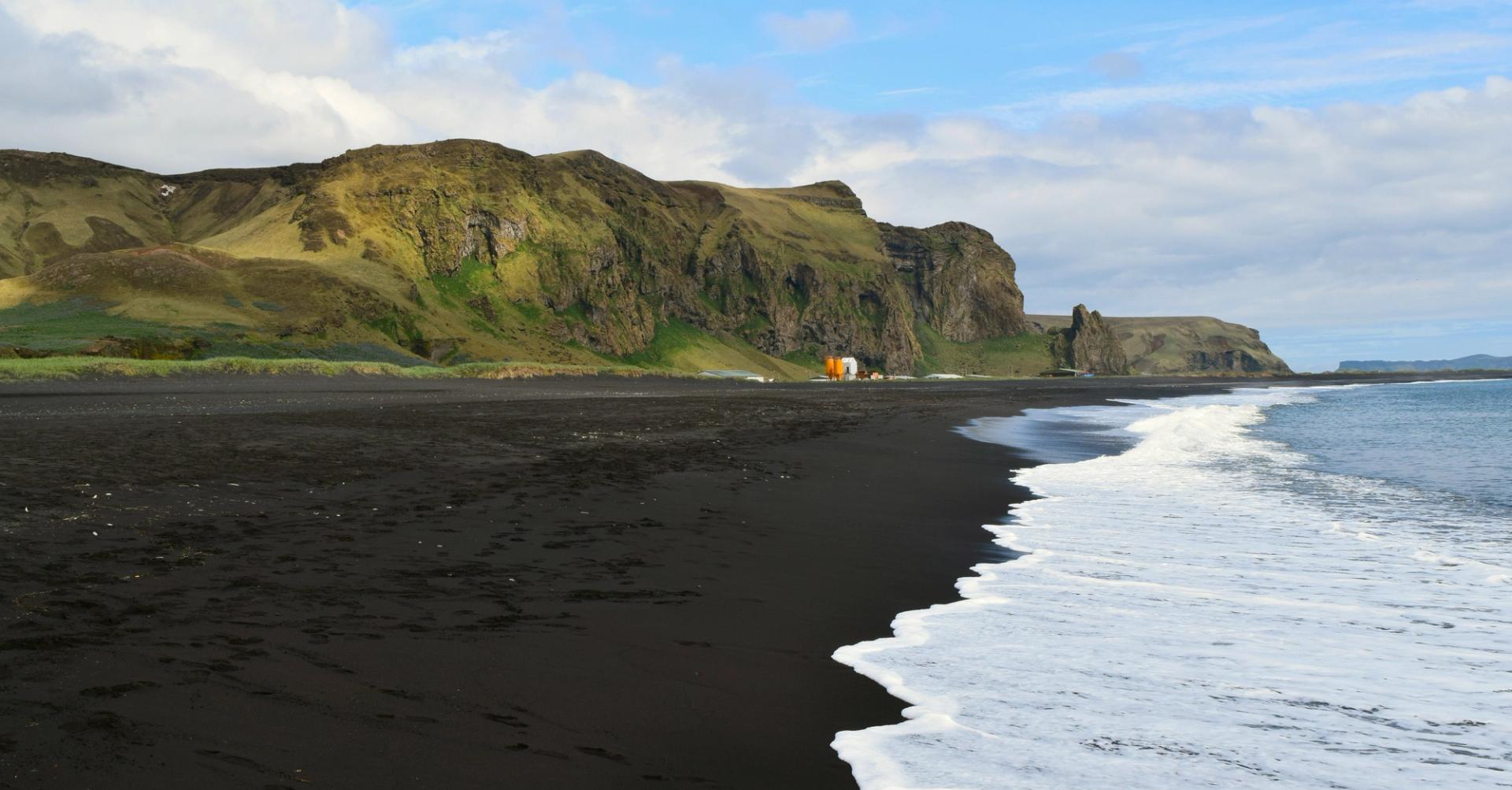 Guides
GuidesGuide to Black Sand Beaches In Iceland (with maps)
Iceland's majestic black sand beaches are some of the most sought-after beaches in the world. Some travelers go to Iceland primarily for them. However, to snap that bucket list photograph or just to see one in real life is a marvel everyone should experience. From a short and quick journey from Reyjavik to the remote South Coast, Iceland has plenty of black sand beaches to explore. So let's talk about where they are and how you can visit them.
Why is the sand black?
The main reason you can find black sand beaches in Iceland is due to the island's volcanic activity.
The black sediment was once formed by boiling hot lava. The lava comes from nearby dormant volcanoes, which have not erupted in a long time but are expected to erupt again in the future. The hot lava would cascade down the beach before eventually cooling off and becoming solid.
However, when cold hits a scorching surface, it can cause the hot surface to break apart. This forms small volcanic rocks, black beach sand, or small pebbles.
Are The Black Sand Beaches Dangerous?
Yes, they can be dangerous and unpredictable. This is primarily due to the alarming sneaker waves that can come out of nowhere.
While you usually can see big waves in the distance at the beach, sneaker waves are the opposite. They hit further up the shore and have nothing to do with weather or wind speed. This means there is no warning that they are coming at all.
In addition to the waves, Iceland's ocean also has strong offshore currents. That, combined with the freezing cold water, is why you won't find any swimming beaches in the country. A strong wind with a sneaker wave can be fatal for anyone caught in it.
Over the last 15 years, about four people were fatally killed by sneaker waves at the most popular black sand beach, Reynisfjara. The deaths occurred between 2007 and 2022 and were caused by drowning once they were pulled into the water. The most recent fatality happened in June of 2022. There have been even more reports of tourists getting caught in these waves, but most of them were, fortunately, able to return to the shore.
So should you avoid the beaches altogether?
No, absolutely not. You just need to be aware and follow some common-sense rules. First, do not stand near the ocean. While you may typically put your toes in the water on beach days, you are better off standing back and keeping your distance.
In addition to that, never turn your back on the water. It is easy to get distracted by all of Iceland's beauty. But if you are near the water, do not lose sight of it.
The Most Popular Black Sand Beaches of Iceland
Diamond Beach
If you are looking for a literal hidden gem in the eastern part of Iceland, look no further than Diamond Beach. Located five hours southeast of Reykjavik, the beach is a Breiðamerkursandur glacial plain that is situated by JökulsárlónGlacier Lagoon. It is also near the highest mountain peak in Iceland, Hvannadalshnjúkur. But the actual beach is located off of Ring Road, making it an easy stop for those along the route.

The black sand beach is eleven miles long, perfect for exploring. The icebergs travel from Jökulsárlón, in the water next to the beach, where you will see hundreds of icebergs floating around! The icy jewels resemble huge diamonds, contrasting nicely with the black volcanic sand.
It is one of the most photographed black sand beaches in Iceland because of this. Photographers visit during sunset, hoping to capture the colorful sky reflecting off the icebergs.
Want to see where the icebergs of Diamond Beach come from? Then take a boat tour with Ice Lagoon Zodiac Boat Tours, conveniently located across the street from the beach. Next, you will visit the Jökulsárlón glacier lagoon and go to the glacial wall. Finally, if you are lucky enough, you will see the glacial chunks, or diamonds, falling off the side.
How Far is Diamond Beach from Reykjavik?
Diamond Beach is located five hours southeast of Reykjavik
Djúpalónssandur Beach
Located 3 hours north-west of Reykjavik on the west coast of Iceland is the infamous Djúpalónssandur Beach, more commonly referred to as the Black Lava Pearl Beach. The beach is near the Snæfellsjökull volcano on the Snæfellsnes peninsula.
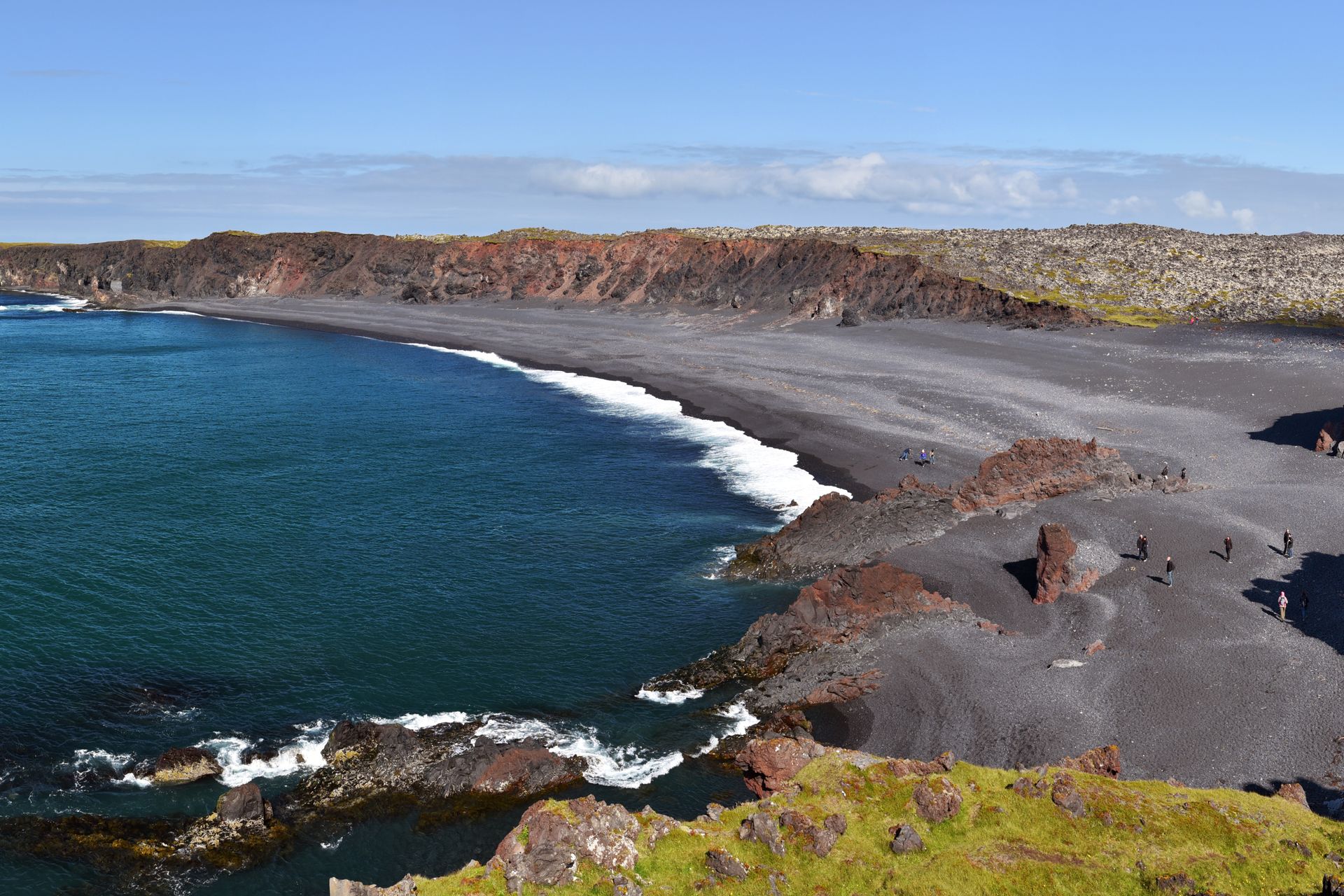
To get here, you will park at the parking lot just above Djúpalónssandur. Then you can reach Black Lava Pearl Beach by walking down the Nautastígur path, also known as "The Path of the Bull." The short hike is extraordinary as you walk through a lava field accompanied by large jagged rocks spiking into the sky.
You will then spot Djúpalónssandur Beach. The beach is made up of an endless amount of black lava pearls, hence the nickname. The small and smooth black pebbles are called Pearls of Djúpalón.
What makes this beach even more unique?
Well, iron pieces from the British trawler, The Epine GY7, lie on the beach. The shipwreck happened on March 13th, 1947, just east of Dritvík cove.
A dangerous blizzard hit Iceland, causing the fisherman to fall into the cold sea. The Icelandic rescue team saved five men over two hours in the cold water. Sadly, fourteen men lost their
How Far is Djúpalónssandur Beach from Reykjavik?
Djúpalónssandur Beach is 2 hours and 49 minutes north-west of Reykjavik.
Reynisfjara Beach
Iceland's most famous black sand beach is the breathtaking Reynisfjara Black Sand Beach. This beach is located on the South Coast of Iceland by the well-known town of Vik. It is easy to get to, as it is situated conveniently along Ring Road. This means it is just far away enough to still attract a lot of visitors, without it being completely overcrowded.
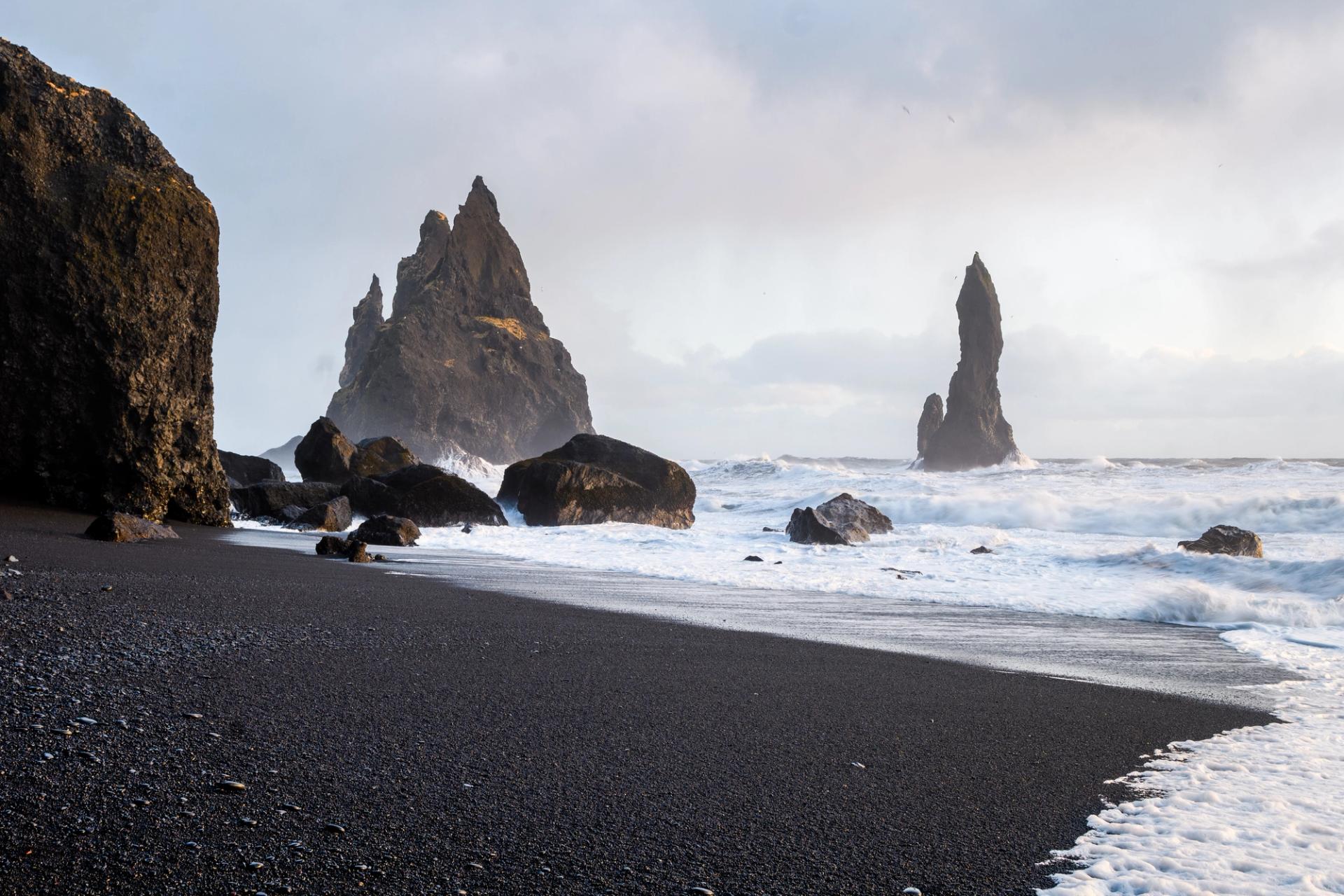
The dramatic black sand pairs nicely with the misty ocean and rocky sea stacks at Reynisfjara Beach. It is rumored that the sea stacks were formed by two trolls who attempted to drag a ship to land. They were then turned into the towering basalt sea stacks which rise from the ocean. The Reynisdrangar sits high in the sea, making an unusual backdrop to your black sand beach photograph.
Reynisfjara Black Sand Beach can be enjoyed any time of the year too. It can be even prettier to see on stormy days as well. The gray sky and the black sand can provide a spooky contrast to the already enchanting views.
The beach is so famous that in 1991 National Geographic even rated it one of the Top 10 Non-Tropical Beaches to Visit On The Planet. Since then, it has continued to live up to its name!
How Far is Reynisfjara Beach from Reykjavik?
Reynisfjara Beach is a two-and-a-half-hour drive southeast of Reykjavik.
Dyrholaey
Located about twenty minutes from Reynisfjara Beach is Dyrholaey.
This area is home to the fabulous "Endless Black Beach." The Dyrhólaey Peninsula is a special little place that is accessible right off Ring Road. Dyrhólaey translates to Door Hill Island as it was an island before it joined the mainland. It was once a volcanic island and today is a nature preserve.
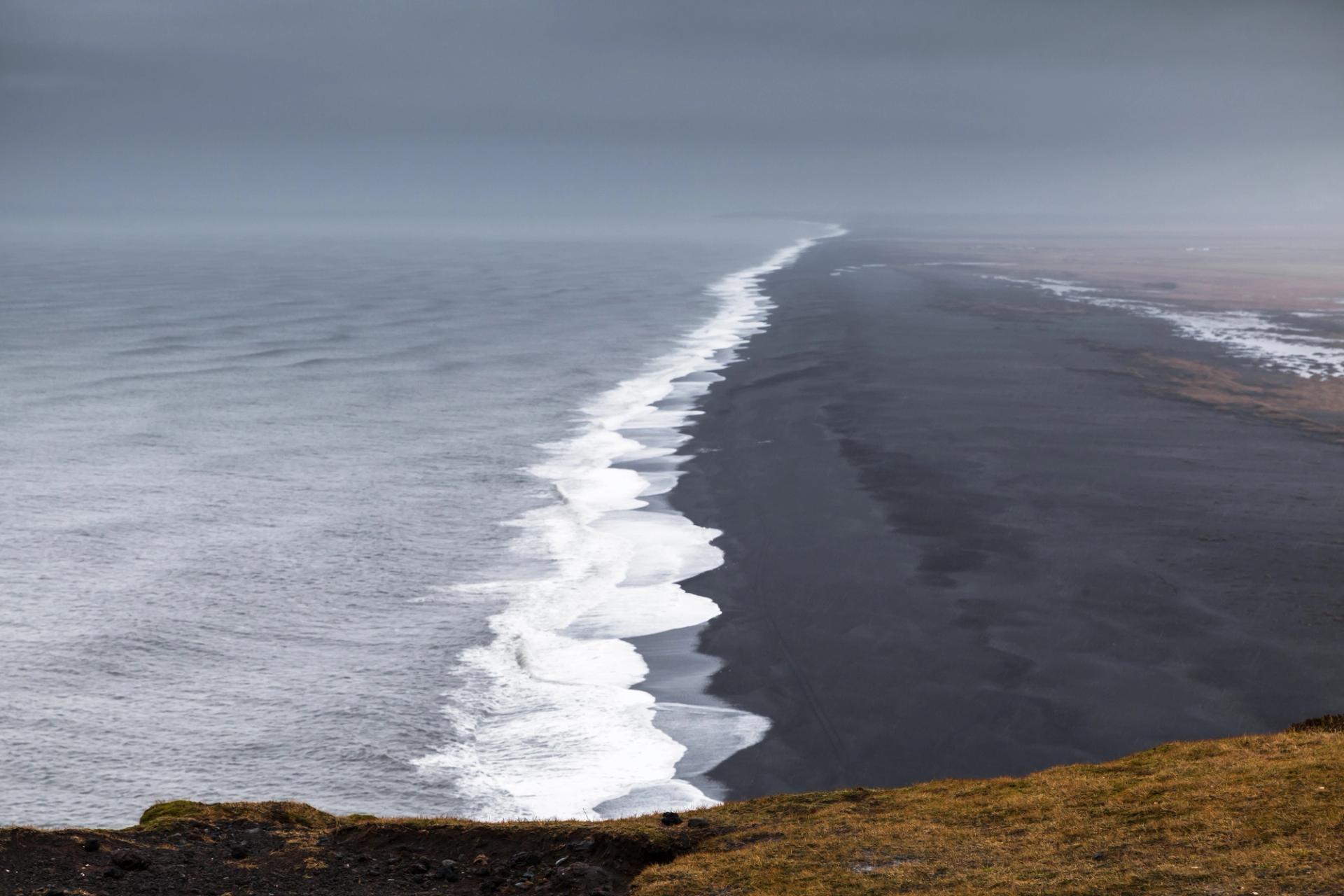
Take a walk over to the lighthouse, where you can enjoy astonishing views of the black beach.
The Dyrholaey is also famous for its arch-shaped cliff. Take a quick walk out on the arch, almost 200 feet high. In 1993, a risky pilot flew through the arch!
Even today, boats can go through it due to its size. It is truly a feature of Dyrholaey to marvel at.
There is wildlife in the nature area too, including many different birds. You will have a chance to spot puffins during the summer months. Most people spend around two hours exploring Dyrhólaey. We recommend stopping here and enjoying the beautiful area.
How Far is Dyrholaey Beach from Reykjavik?
Dyrholaey is a two-and-a-half-hour drive southeast of Reykjavik.
Solheimasandur – The DC3 Plane Wreck
Visit the back sand beach where the historic Sólheimasandur DC Plane Crash took place! In 1973, the small DC plane had to make a crash landing due to a lack of de-icing and low fuel on the airplane on the black sand beach. Fortunately, it was a safe landing, and everyone survived.
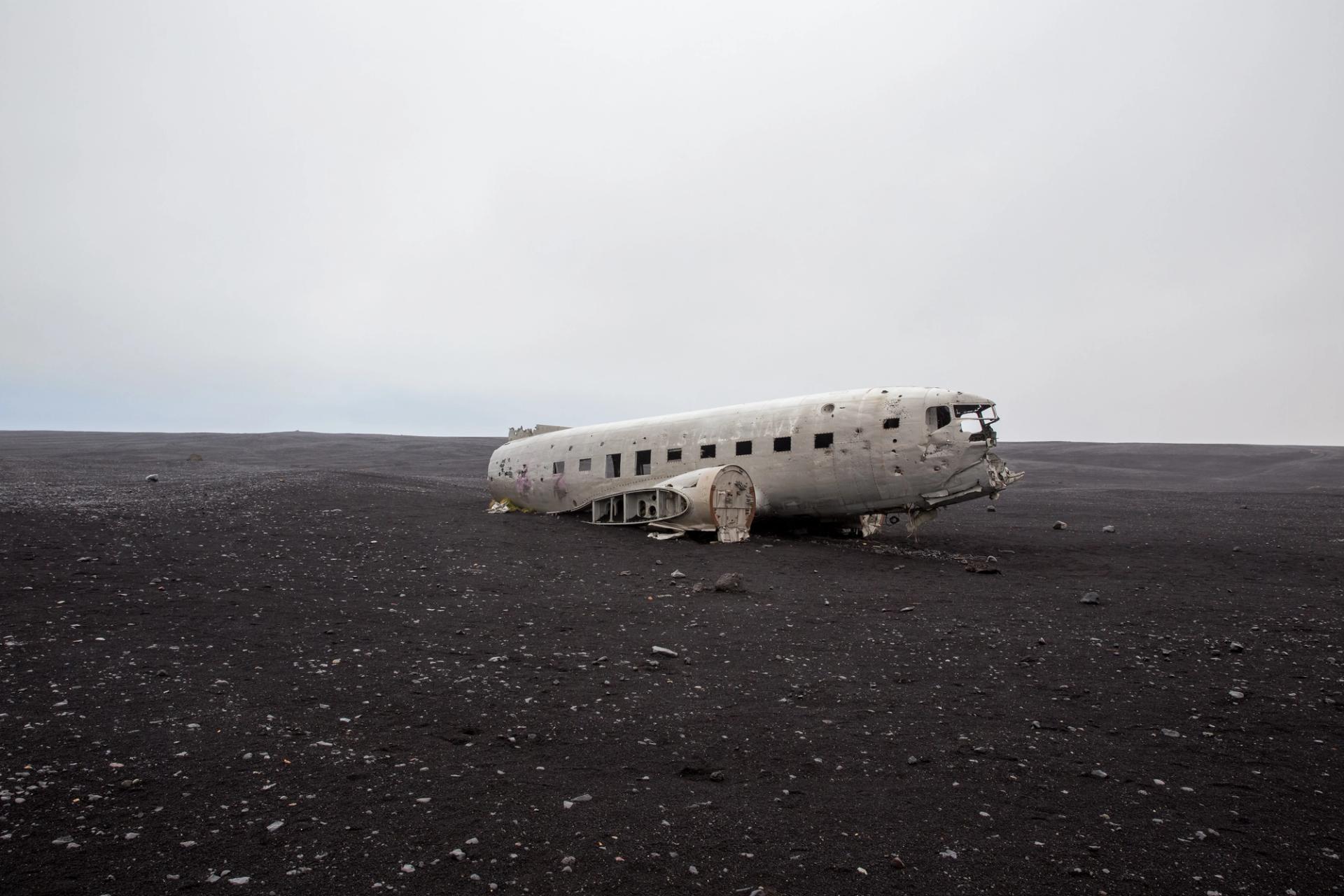
Now you can hike to the wreckage site. You can reach the parking lot at FJRP+9J8, Path to Wrecked DC-3 Plane on Sólheimasandur, 871 Iceland.
You will see a small sign displaying parking for the plane wreckage site. The four-mile round trip hike is enjoyable and relaxed most of the way on a gravel path. Then you will see the black sand beach with the plane sitting in the middle. You can even go inside the plane and snag some breathtaking photos.
We recommend going on a stormy day, where you can snap a photograph of the white plane shell against the dramatic black beach.
How Far is Sólheimasandur Beach from Reykjavik? This historic stop off the Ring Road is a two and half hour drive southeast of Reykjavik.
Stokksnes
Sitting near the town of Hofn in Southeast Iceland is the majestic Stokksnes. Due to it being about a six-hour drive from Reykjavik, this beach often gets missed. Making it one of the less crowded black sand beaches in the whole country. Luckily, it is a quick detour off Ring Road and about an hour from Diamond Beach.
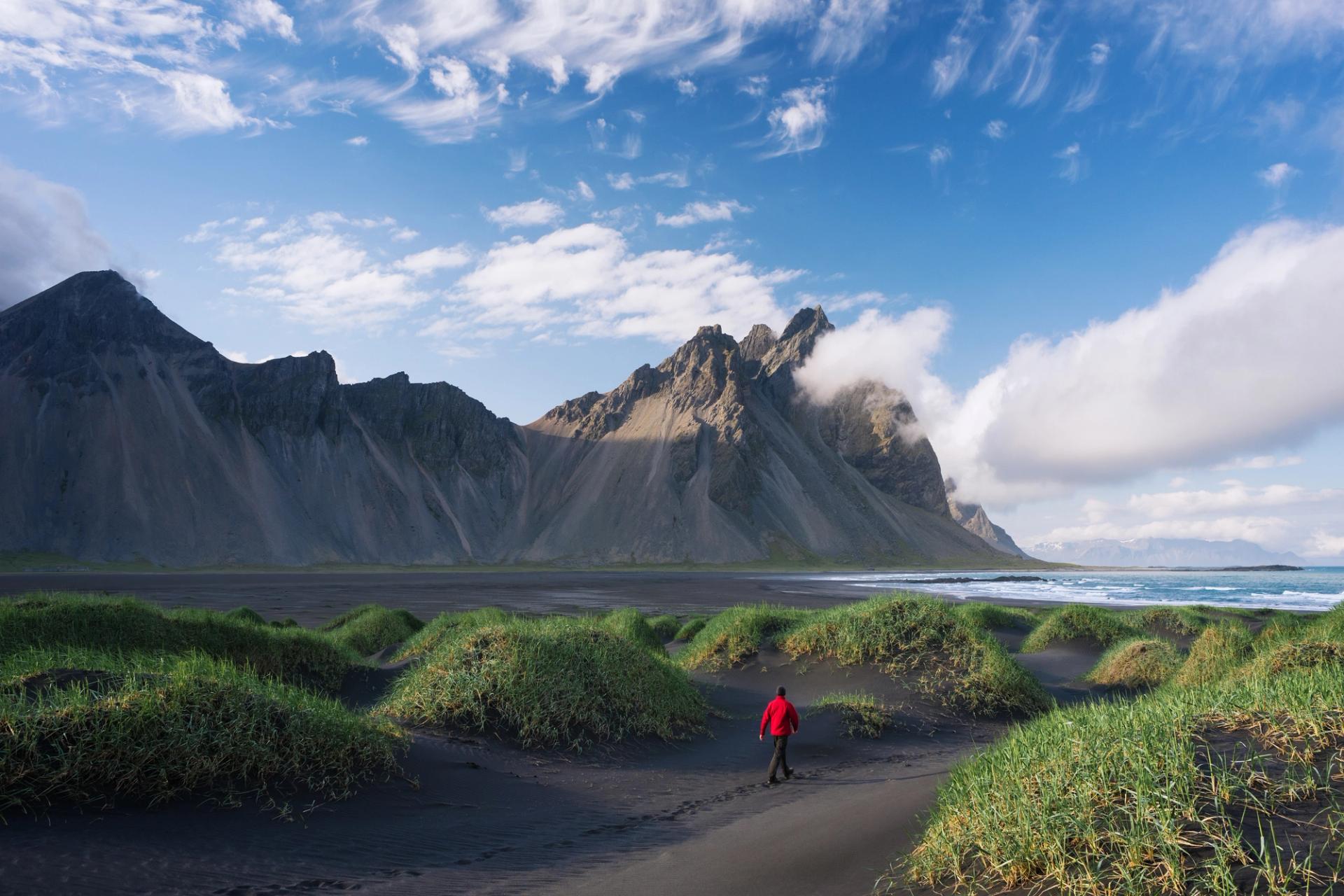
The main attraction at the beach is the huge mountain peaks that go as high as 1490 ft, rising from the sides of the lagoon. If you stand on the beach facing the mountains, you can get a really amazing view! The dramatic black sand is the foundation of the photo as the white mountain peaks sit in the background. The dark blue and rugged sea is just an added bonus for your photograph.
The beach is on private land, but don’t worry you can still visit it. You do have to pay a small entrance fee to go. The fee goes towards the maintenance and upkeep of Stokksnes. If you are looking for a less visited, tranquil, and peaceful black sand beach, then Stokksnes is the one for you.
How Far is Stokksnes Beach from Reykjavik?
Stokksnes is a six-hour drive southeast of Reykjavik.
Seltjörn
Looking for a short and sweet visit to a black sand beach from Reyjavik?
Seltjörn is the perfect option for you. The beach is a quick 10-minute drive from the city. Seltjörn may not be the most vibrant black sand you will see, over the years it turned more of a deep gray. But, it is still beautiful enough to earn a spot on our list
If you visit the beach after a heavy rainfall or during a misty morning, the sand will appear more black than gray. When it is dry and sunny, you will notice lighter gray sand. Either way, you can grab some magnificent photographs here, regardless of what color it is.
The surrounding area is another reason to visit here. It is a popular nature area with the locals of Reykjavik, an excellent place to go and escape for the day.
There is a pond that is accompanied by walking paths for you to take a stroll along. You can have lunch at one of their picnic facilities which has barbeque grills. If fishing interests you, the pond here features brown trout and arctic charr.
Then spend some time exploring the Sólbrekkuskógur forest, which sits right next to Seltjörn. Enjoy the trees as well as the unique rock formations. Seltjörn is more than just a faded black sand beach, it is a recreational area that you can spend the whole day at!
How Far is Seltjörn Beach from Reykjavik?
Seltjörn is a ten-minute drive west of Reykjavik.
Lake Myvatn
While this spot usually doesn’t land high on the list of Iceland’s black sand beaches, it truly is a marvelous area. Lake Mývatn is a volcanic lake, which explains the area’s black sand beaches. It is even known to be Iceland’s fourth-largest body of water and is located off the shore of the Reykjahlíð village. Mývatn is simply a region of lakes.
There are also some small black sand beaches here.
The area of Skútustaðagígar has some small sections of black and pebbles and sand. Skútustaðagígar is a series of pseudocraters formed by lava flow. Which is exactly why you can spot some here! Journey around the area and look for these very small but still beautiful black sand beaches.
How Far is Lake Myvatn Beach from Reykjavik?
Lake Myvatn is a six-hour drive north of Reykjavik.
Black Sand Beaches FAQ
Can I take sand from the black sand beaches?
No, you are not allowed to take sand from the black sand beaches of Iceland. This disrupts the environment. If everyone took a bag of sand from the beach, none would be left!
How much time do you need at Reynisfjara Beach?
You only need about 40 minutes to an hour here. It depends on whether you want to sit and relax, grab your photograph, and keep on going. Depending on the time of the year, you can spot puffins here. Also, the sunset is breathtaking!
Is Reynisfjara beach free?
Yes, the entrance to Reynisfjara Beach is free for the public. You will not need to pay for parking there either.
Latest Blog Posts
 Guides
GuidesThe 2022 Eruption of Fagradalsfjall Volcano - An Unforgettable Iceland Volcano Eruption
Iceland has become a top destination for mind-blowing mountain hikes, volcanic hot springs, and icy glaciers. Adventurers flock to the land of fire and ice to experience these thrilling opportunities! So it is no wonder why Iceland's volcanic eruptions attract visitors from all over the world!
 Waterfalls
WaterfallsGuide to Svartifoss Waterfall in Iceland
Svartifoss, or the 'Black Waterfall', is an exquisite natural wonder tucked away in the Vatnajökull National Park of Iceland. Known for its distinctive basalt columns and cascading water, this waterfall is a must-see for nature lovers and travelers.
 Itineraries
ItinerariesTop 11 Must-Visit Volcanic Sites in Iceland
Iceland has over 130 volcanoes located throughout the country, with 30 of them still active today. Some of them are famous for recent volcanic eruptions, while others have not erupted in thousands of years. There are so many notable Iceland volcanoes, it is hard to know which ones you can visit. With the nickname of The Land of Fire and Ice, you know you won’t be disappointed when it comes to Iceland's volcanic sites. Here are our top 11 must-visit volcanic sites in Iceland!